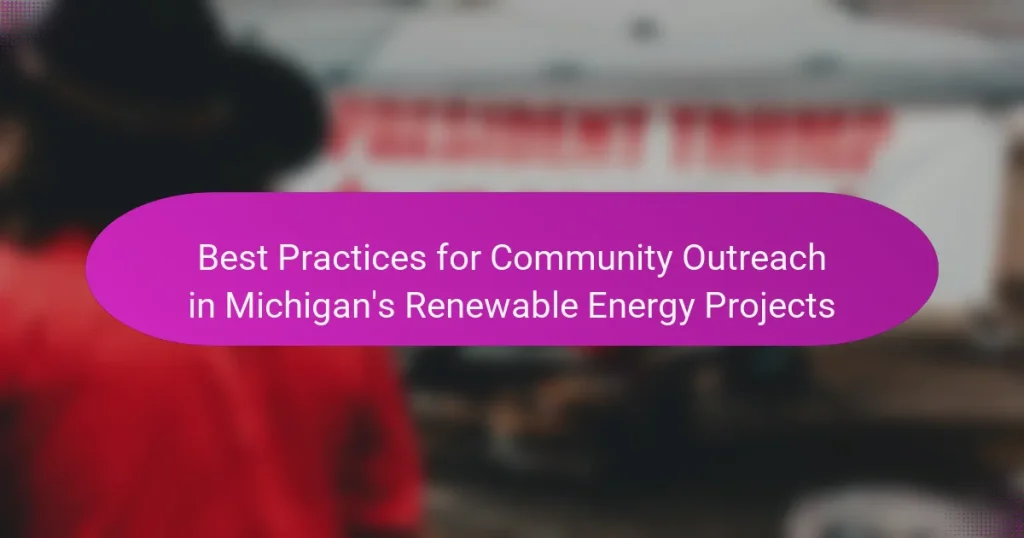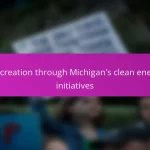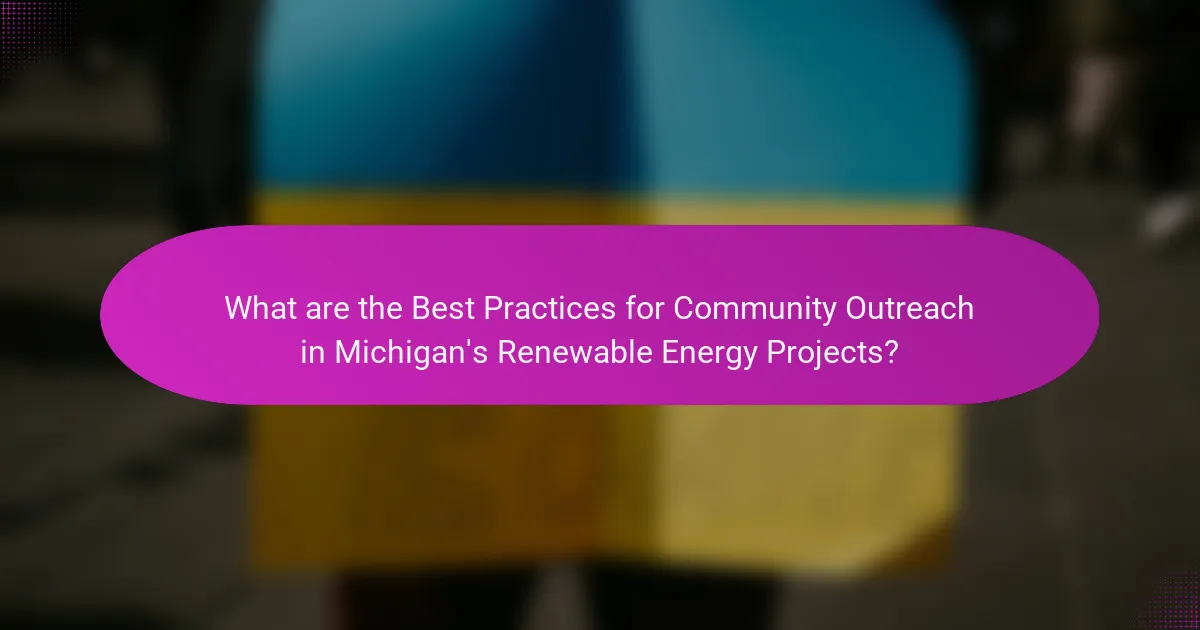
What are the Best Practices for Community Outreach in Michigan’s Renewable Energy Projects?
Effective community outreach in Michigan’s renewable energy projects includes early engagement, transparency, and education. Early engagement fosters trust and allows for community input in project planning. Transparency about project goals and impacts builds credibility among stakeholders. Educational initiatives help residents understand renewable energy benefits and technologies. Utilizing local media and social platforms enhances outreach effectiveness. Hosting public meetings encourages dialogue and addresses community concerns. Collaborating with local organizations can strengthen outreach efforts. Tailoring communication to diverse community needs ensures inclusivity. These practices lead to more successful and accepted renewable energy projects in Michigan.
How can effective communication enhance community outreach efforts?
Effective communication enhances community outreach efforts by fostering trust and engagement. Clear messaging ensures that community members understand project goals and benefits. This understanding encourages participation and collaboration. Regular updates keep the community informed about progress and changes. Engaging stakeholders through dialogue allows for feedback and concerns to be addressed. Research shows that effective communication can increase community support by up to 50%. In Michigan’s renewable energy projects, this support is crucial for successful implementation and sustainability.
What communication channels are most effective for engaging communities?
Social media platforms are the most effective communication channels for engaging communities. They allow for real-time interaction and feedback. Platforms like Facebook and Twitter enable organizations to share updates quickly. Visual content on Instagram can capture attention and encourage participation. Community forums foster discussions and allow for in-depth conversations. Email newsletters provide direct communication to interested parties. Research shows that 70% of people prefer social media for community engagement. This preference highlights the importance of utilizing these channels effectively.
How can transparency in messaging build trust with stakeholders?
Transparency in messaging builds trust with stakeholders by fostering open communication. Clear and honest information reduces uncertainty. Stakeholders feel valued when they receive timely updates. This practice encourages engagement and collaboration. Research shows that transparency leads to higher satisfaction levels among stakeholders. According to a study by the International Association for Public Participation, transparent processes enhance community trust. Trust is critical for successful renewable energy projects in Michigan. Stakeholders are more likely to support initiatives when they understand the decision-making process.
Why is community involvement crucial in renewable energy projects?
Community involvement is crucial in renewable energy projects because it fosters local support and enhances project success. Engaging the community ensures that the needs and concerns of residents are addressed. This involvement can lead to increased public acceptance and reduced opposition. Studies show that projects with strong community engagement are more likely to be completed on time and within budget. Additionally, local participation can provide valuable insights into site selection and project design. According to a report by the National Renewable Energy Laboratory, community-supported projects often result in higher levels of satisfaction among stakeholders. Thus, community involvement is essential for the effective implementation of renewable energy initiatives.
What role do local communities play in the success of these projects?
Local communities are essential for the success of renewable energy projects. They provide local knowledge and insights that can shape project development. Community support can lead to smoother project implementation and reduce opposition. Engaging local stakeholders fosters trust and collaboration. This involvement often results in better alignment with community needs and values. Studies show that projects with strong community engagement have higher success rates. For example, the Michigan Renewable Energy Program highlights successful partnerships with local groups. These collaborations enhance project sustainability and acceptance.
How can community feedback shape project development?
Community feedback can significantly shape project development by providing insights that align projects with local needs. Engaging with community members helps identify specific concerns and preferences. This feedback can lead to modifications in project design or implementation strategies. Research shows that projects incorporating community input tend to have higher acceptance rates. For instance, a study by the National Renewable Energy Laboratory found that community involvement can enhance trust and reduce opposition. Adapting projects based on feedback fosters a sense of ownership among residents. This involvement can also lead to innovative solutions that might not have been considered otherwise. Ultimately, integrating community feedback leads to more successful and sustainable project outcomes.
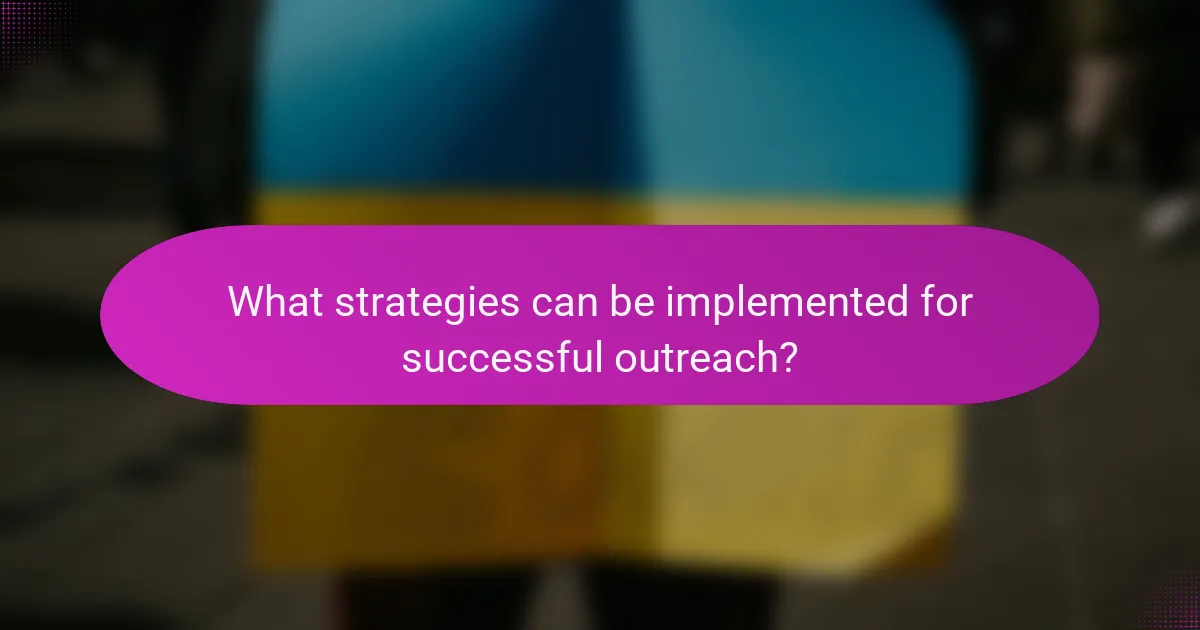
What strategies can be implemented for successful outreach?
Successful outreach strategies include engaging the community through transparent communication. This involves sharing clear information about renewable energy projects. Utilizing local media can amplify outreach efforts. Hosting community meetings fosters direct dialogue and feedback. Collaborating with local organizations enhances credibility and reach. Providing educational resources helps demystify renewable energy concepts. Tailoring messages to address community concerns increases relevance and impact. Evaluating outreach effectiveness through surveys ensures continuous improvement.
How can partnerships with local organizations improve outreach?
Partnerships with local organizations can significantly improve outreach by leveraging established community trust. Local organizations often have deep roots and credibility within their communities. This connection facilitates better communication and engagement with residents. For instance, studies show that outreach efforts are more effective when conducted through trusted local entities. Collaborating with local groups can also enhance resource sharing, making outreach initiatives more efficient. Furthermore, these partnerships can lead to increased participation in renewable energy projects, as local organizations can mobilize community members effectively. Evidence from successful outreach programs highlights the positive impact of such collaborations on community involvement and awareness.
What types of organizations should be targeted for partnerships?
Local governments should be targeted for partnerships. They have the authority to facilitate renewable energy projects. Nonprofit organizations focused on sustainability are also key partners. They can mobilize community support and resources. Educational institutions can provide research and innovation. They often have access to expertise and student engagement. Utility companies are crucial for infrastructure and energy distribution. Collaborating with them can enhance project feasibility. Additionally, community advocacy groups can help reach diverse populations. Their networks can foster broader community involvement.
How can collaborative events foster community engagement?
Collaborative events can foster community engagement by creating shared experiences among participants. These events encourage interaction and dialogue, allowing community members to connect over common interests. They provide a platform for diverse voices to be heard, promoting inclusivity. Collaborative events often involve local stakeholders, which strengthens community ties. Research shows that community involvement in decision-making leads to higher levels of satisfaction and support for local projects. For instance, a study by the Michigan State University Extension found that collaborative initiatives in renewable energy projects resulted in increased community trust and participation. Thus, collaborative events serve as a vital tool for enhancing community engagement.
What educational initiatives can support outreach efforts?
Educational initiatives that can support outreach efforts include community workshops, informational seminars, and school programs. Community workshops provide hands-on experiences and discussions about renewable energy. Informational seminars can educate residents on the benefits and opportunities associated with renewable projects. School programs can engage students in learning about sustainability and energy conservation. Research shows that community engagement increases public support for renewable energy initiatives. The National Renewable Energy Laboratory reported that informed communities are more likely to participate in renewable projects. These initiatives foster awareness and build trust within the community.
How can workshops and seminars inform the community about renewable energy?
Workshops and seminars can inform the community about renewable energy by providing direct education and resources. These events facilitate discussions on renewable energy technologies and their benefits. They can feature expert speakers who share insights on solar, wind, and other renewable sources. Participants can engage in hands-on activities that demonstrate renewable energy applications. Workshops can also address common misconceptions and answer community questions. Furthermore, they provide networking opportunities with local energy advocates. According to the U.S. Department of Energy, community engagement through workshops enhances public understanding and support for renewable projects. This approach fosters a more informed community that is better prepared to adopt sustainable practices.
What resources are available for developing educational materials?
Various resources are available for developing educational materials. These include online platforms, educational institutions, and government agencies. Websites like the U.S. Department of Energy provide comprehensive guides and toolkits. Nonprofit organizations often offer free resources tailored to community education. Local universities may have programs or partnerships for curriculum development. Additionally, community workshops can serve as a practical resource for hands-on learning. These resources help ensure that educational materials are accurate and relevant to the target audience.
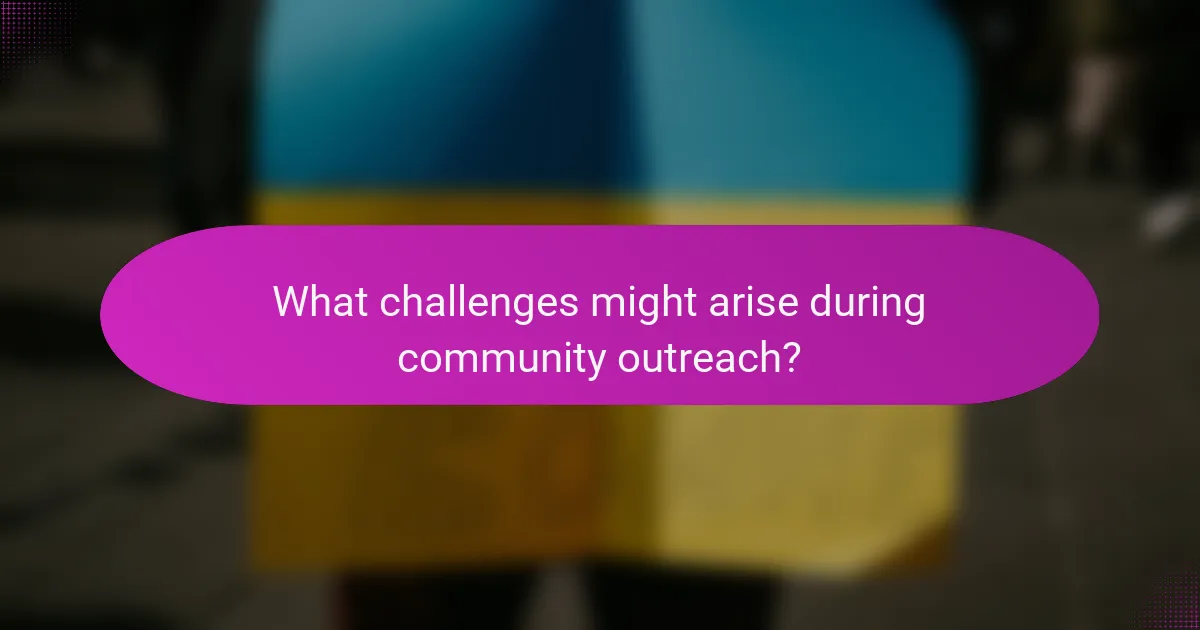
What challenges might arise during community outreach?
Challenges during community outreach include communication barriers, distrust, and resource limitations. Communication barriers often arise due to varying literacy levels and language differences among community members. Distrust can stem from past negative experiences with organizations or government entities. Resource limitations may include insufficient funding and staffing to effectively engage the community. Additionally, differing priorities and interests among stakeholders can complicate outreach efforts. These challenges can hinder the effectiveness of outreach initiatives and reduce community participation.
How can misconceptions about renewable energy projects be addressed?
Misconceptions about renewable energy projects can be addressed through effective communication and education. Engaging with the community is essential for clarifying misunderstandings. Providing accurate information about the benefits and impacts of renewable energy fosters trust. Hosting informational sessions allows community members to ask questions and express concerns. Utilizing local media can help disseminate factual information widely. Collaborating with local organizations can enhance credibility and reach. Sharing success stories from similar projects can demonstrate viability and benefits. Research shows that informed communities are more supportive of renewable initiatives. A study by the National Renewable Energy Laboratory found that community engagement significantly reduces opposition to renewable projects.
What common myths exist regarding renewable energy in Michigan?
Common myths regarding renewable energy in Michigan include the belief that it is too expensive. In reality, the cost of renewable energy has significantly decreased over the past decade. According to the U.S. Department of Energy, the levelized cost of solar energy has dropped by 89% since 2009. Another myth is that renewable energy cannot provide reliable power. However, Michigan’s renewable resources, including wind and solar, can meet energy demands effectively. Studies show that states with high renewable energy integration maintain grid reliability. Additionally, some believe that renewable energy requires too much land. In fact, innovative technologies allow for energy generation on smaller footprints, such as rooftop solar installations. Lastly, there is a misconception that renewable energy jobs are not significant. The Michigan Energy Innovation Business Council reports that renewable energy jobs have been growing, contributing to the local economy.
How can accurate information counteract these misconceptions?
Accurate information can effectively counteract misconceptions in community outreach for renewable energy projects. By providing clear and factual data, stakeholders can address fears and misunderstandings about renewable energy. For instance, statistics show that renewable energy sources can significantly reduce greenhouse gas emissions, which counters the belief that they are harmful to the environment. Furthermore, transparent communication about project benefits, such as job creation and energy savings, can alleviate concerns from community members. Research from the National Renewable Energy Laboratory indicates that informed communities are more likely to support renewable initiatives. This evidence underscores the importance of delivering accurate information to foster trust and engagement in renewable energy projects.
What are the best practices for managing community concerns?
Engaging effectively with community concerns involves several best practices. First, establish transparent communication channels. Regular updates and open forums foster trust. Second, actively listen to community feedback. Surveys and public meetings can gather valuable insights. Third, involve community members in decision-making processes. Collaborative efforts enhance community ownership of projects. Fourth, provide clear and accessible information about renewable energy benefits. Educating the community can alleviate misconceptions. Fifth, address concerns promptly and respectfully. Timely responses show commitment to community well-being. Lastly, build long-term relationships with stakeholders. Sustained engagement leads to ongoing support and understanding. These practices are supported by successful case studies in community outreach initiatives in Michigan’s renewable energy sector.
How can project developers effectively listen to community feedback?
Project developers can effectively listen to community feedback by implementing structured engagement processes. They should conduct surveys to gather opinions and preferences from community members. Organizing public meetings allows for direct interaction and discussion. Developers can also create online platforms for continuous feedback collection. Engaging with local organizations can help reach diverse community segments. Actively responding to feedback shows that developers value community input. Documenting feedback and sharing how it influences project decisions builds trust. Studies indicate that projects with strong community engagement have higher success rates.
What strategies can be employed to resolve conflicts with local residents?
Engaging local residents through open communication is a key strategy for resolving conflicts. This involves hosting public meetings to discuss project details and gather feedback. Active listening is essential to understand residents’ concerns. Providing transparent information about the project’s benefits and impacts fosters trust. Establishing a local advisory committee can ensure ongoing dialogue. Offering solutions that address specific resident concerns can mitigate negative perceptions. Collaborating with local leaders enhances community support. Implementing feedback into project planning demonstrates responsiveness. Evidence shows that projects with strong community engagement experience fewer conflicts and greater acceptance.
What practical tips can enhance community outreach in renewable energy projects?
Engaging the community effectively enhances outreach in renewable energy projects. Start by identifying local stakeholders and their interests. Conduct surveys to understand community needs and preferences. Host informational workshops to educate residents about renewable energy benefits. Utilize social media platforms to share updates and gather feedback. Establish partnerships with local organizations to broaden outreach efforts. Provide transparent information on project timelines and impacts. Offer incentives for community participation, such as discounts or rebates. Regularly assess outreach strategies to improve engagement based on community response.
How can ongoing engagement be maintained after project completion?
Ongoing engagement can be maintained after project completion through regular communication and community involvement. Establishing a feedback loop allows stakeholders to voice their opinions and suggestions. Hosting periodic community meetings fosters transparency and trust. Providing updates on project impacts and future initiatives keeps the community informed. Utilizing social media platforms enhances outreach and interaction. Creating volunteer opportunities encourages community participation. Surveys can gather insights on community needs and interests. Collaborating with local organizations strengthens relationships and support networks.
What are the key indicators of successful community outreach efforts?
Key indicators of successful community outreach efforts include community engagement, feedback, and measurable outcomes. Community engagement is demonstrated through participation rates in outreach activities. High attendance at events indicates interest and involvement. Feedback from community members reveals perceptions and satisfaction levels. Positive feedback suggests effective communication and relatability. Measurable outcomes assess the impact of outreach initiatives. These can include increased awareness of renewable energy projects or changes in community attitudes. Data collection methods, such as surveys, can quantify these outcomes. Research shows that effective outreach correlates with higher community support for renewable energy initiatives.
The main entity of the article is community outreach in Michigan’s renewable energy projects. The article outlines best practices for effective outreach, emphasizing early engagement, transparency, and education to foster trust and collaboration among stakeholders. It discusses the role of communication channels, community involvement, and partnerships with local organizations in enhancing outreach efforts. Additionally, the article addresses challenges in outreach, common misconceptions about renewable energy, and strategies for managing community concerns, ultimately highlighting the importance of sustained engagement for project success.
